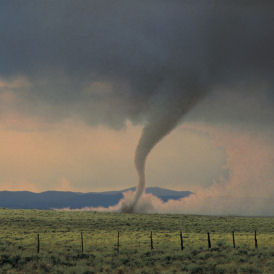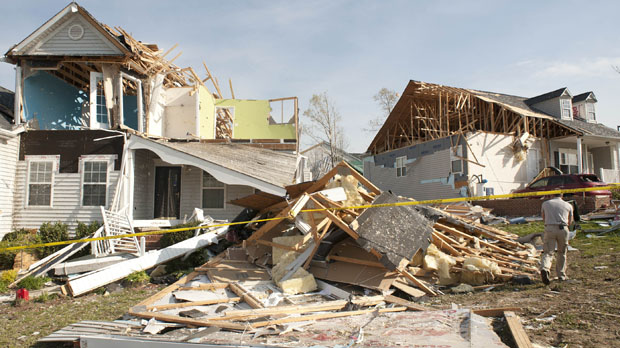What caused the Alabama tornadoes?
How are tornadoes formed, and why were the twisters in Alabama so devastating? Channel 4 News speaks to the experts.

Tornadoes and storms ripped through Alabama in the United States on Wednesday, leaving at least 220 dead. US President Barack Obama has declared a state of emergency in the region amid fears that the death toll will rise, and a million people are believed to be without power.
Paul Knightley, Senior Forecaster at MeteoGroup, told Channel 4 News that, from the information and images seen so far, the storms seemed incredibly powerful.
“Looking at these images, the tornadoes in Alabama seem to be about as big as tornadoes can get,” he said.
He said the storms appear to have been up to a mile across, and could have had winds travelling at up to 200 miles per hour. They also seem to have been travelling very fast across the ground – at 50 or 60 miles an hour.
All of these figures suggest abnormally large, powerful storms – and lots of them – hit the area, causing devastation. The fact that there were so many is also rare, Mr Knightley said.

Mr Knightley added: “Usually, conditions for these types of storm are only found very locally. But yesterday they were over a vast area, several states, hundreds of square miles, so there were more.”
The speed they travelled at would have been terrifying, he said.
“You could be looking at these storms a mile away on the horizon, then in one minute they were at your house,” he said.
What is a tornado?
A tornado is a violent rotating column of air which can cause major damage to life and property. It extends from a thunderstorm in the atmosphere to the ground.
How are tornadoes caused?
MeteoGroup's Paul Knightley told Channel 4 News a simple way to think of a tornado is a bit like "water going down a plughole."
"The conditions for a thunderstorm are warm, moist air and an unstable atmosphere. The warm air wants to rush up, like a hot air balloon. That happens all the time but you need special conditions for a super cell thunderstorm, or rotating thunderstorm. These are very rare.
"You get rotations when you get wind shear - when the wind changes direction as you go up into the atmosphere. So it could be southerly, at 30 miles per hour on the ground; south-westerly, at 60 miles per hour a mile up; and six miles up it could be westerly at 120 miles per hour. Wind shear causes the air to rotate, a bit like a rolling pin, or at least it wants to rotate in this way. The thunderstorm tilts this rolling pin on its end and that's the super cell thunderstorm.
"These are very, very powerful storms. How it gets to the ground is not fully understood but wind shear is part of it."
What makes tornadoes big or fast moving?
Mr Knightley explained: "Super cell storms, the parent storm of a tornado, are governed by the strength of the wind. So the storm is not an object, but you can picture it as an object in a stream - if it's a fast stream, it's a fast storm."
Some of the Alabama storms were also very wide - up to a mile wide compared to the norm of several hundred metres - and had fast winds, up to 200 miles per hour compared to the norm of 100 miles per hour. This is due to the power of the storm above, so it is all linked, Mr Knightley said.
He said: "It's too early to know but on the enhanced Fujita Scale of tornadoes, which goes from 1-5 in terms of intensity, looking at the damage we've got at least EF3 or 4, maybe 5."
High death toll
Ross Reynolds, Senior Teaching Fellow at the University of Reading’s Department of Meteorology, told Channel 4 News that a host of factors could have caused the “unusually high” death toll.
“The death toll is unusually large – in 1999 in Oklahoma, there was a huge outbreak of 70 tornadoes, but only 40 people died,” he said.
He said more information was needed to ascertain why so many people were killed by the storms, but said a number of factors could be involved.
“The warning system is very good – it tends to beak into TV transmission, radio, showing radar pictures and saying the tornado is approaching here, it will hit in ten minutes, for example. But the people have to react and do certain things and if they are not used to that, they may not know what to do. Or if it is at night, some struck at night, that is obviously difficult,” he said.
“This area does get hit by tornadoes a lot – but if there were lots of storms, there’s a bigger risk of more damage. Or if they hit poorer areas – in America, the trailer parks and caravan parks are susceptible to complete destruction. That could be part of the story.
“Or the storms could simply have been very, very bad, their scale could have been enormous.”
-
Latest news
-
Boy with profound learning disabilities reaches out of court settlement after abuse in residential school7m

-
India election: Modi rivals hit by string of raids and arrests7m

-
Can UK’s abandoned mines be used to build a greener future?5m

-
Sycamore Gap: Man pleads not guilty to felling iconic tree2m

-
‘Child poverty has not fallen since Tories came in’, says Gordon Brown5m

-




